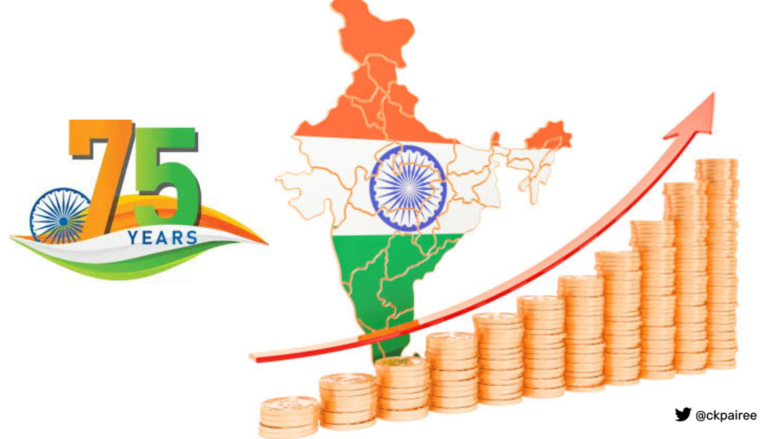How we got here and what lies ahead
India will hit a century in 25 years! We have been hearing the number ‘75’ for a year now and I have been thinking to myself that this would be the best time to look back and think about India’s story since 1947. Borrowing the well-known historian Ram Guha’s line, “If you looked at India as a start-up in 1947, no one would have funded it”. India was dealing with the partition mess, uncertainty & chaos as a country hurriedly put together from over 550 princely states of various ethnicity, languages, religions etc. It was really a sub-continent of many nations akin to a Europe and not really a single country. Most experts around the world gave this experiment a few years to survive. But we were destined for something else.
After 75 years, we have come a long way as one of the world’s leading economies and more than anything, stayed united as a functioning democracy. This in itself is a remarkable achievement given the level of complexity and diversity we have. Each era since the independence came with various phases of growth, either socialism, post-socialism, liberalization and beyond.
To the world, India probably didn’t matter much till the 90s. We were just an old third world British Colony, which was very poor. Many people in USA, where I lived during that period, didn’t even know where India was and had only heard about its poverty, wild animals and snake charmers. Today’s India is different. We are a dynamic nation with a young population and a booming economy. A huge market with over 1.35 billion people, India has the 3rd largest GDP in terms of purchasing power parity in the world and is the 6th largest economy from a nominal GDP perspective. And, a vibrant entrepreneur led economy with 140 billionaires and counting. Let us look at how we got here.
Early days of Socialism
Right after India became independent, much of the focus was on the social aspects. We were then a nation with abject poverty and sharp social differences.
In the first phase, India saw a socialistic model of democracy under Prime Minister Jawaharlal Nehru’s development model. We had to establish strong institutions for the long run including educational institutions like the IITs and IIMs. The state played a key role here in the economic progress. There was a focus on agriculture and irrigation to boost farm output as India was losing precious foreign reserves on foodgrain imports. Perhaps given the complexity of the country, this was the right move back then.
Industrialisation phase
Next came the phase of rapid industrialization with a focus on heavy industries and capital goods. India’s Industrial Policy Resolution paved the way for the development of the public sector and ushered in the licence Raj that categorises industries into exclusively public sector, incrementally state-owned and the private sector. This was the phase where the ‘Navaratnas’ came into existence, when some of the largest public sector industries emerged in various sectors like aviation, machine tool, electronics, telecom and many more.
Renewed focus on Agriculture
There was acute shortage of food in the 1960s and the country was on the verge of a famine and food aids from the US were hitting India’s foreign policy autonomy. The ‘Green Revolution’ helped address this. This was also followed by the ‘White Revolution’ promoting milk and dairy production. Amul as it is today is a great example of its success.
Dark days of the emergency
The 1971 War, droughts and West Asia crisis crippled India’s economy. In 1975, Indira Gandhi’s government officially imposed a state of emergency in India. This was a period when elections were cancelled, and civil liberties suspended. It is till date a very dark period for independent India. It was a time when human rights were violated, and brutal campaigns were implemented. A thing to be noted is that inflation was over 25 per cent on the eve of Emergency. Apart from that, unemployment was high and food riots were common. Farmers, labourers and daily wage workers were the worst hit by these rising prices and unemployment issues on the eve of imposition of Emergency. During this phase, the government responded by imposing even more regulations to control the market and industries. Those measures practically brought investment to a halt and there was further loss of jobs for the people. Banks, transportation and businesses were nationalized, taking India backwards in some sense. The government was forced to withdraw the emergency in 1977 and hold fresh elections where the opposition coalition won the elections for the first time in Indian history by defeating the Congress.
Telecom Revolution of the 80s
Not sure how many of you remember the time when we had to wait months, even years to get a telephone line connection to your house. You had to file an application and wait endlessly. Even calling people from other towns was a chore as you had to book a call in the exchange and wait for them to connect you, if at all it worked! It was the era of ‘Trunk’ calls and ‘Lightning’ calls. The telecom revolution of the 80s led by Sam Pitroda brought an end to our telecom woes. Even to buy a scooter or a two-wheeler, we had to book and wait. The other big change in the late 80s was in Automobiles. Until the 80’s, India had only two cars – the ambassador or the Premier Padmini (old Fiat). The arrival of Suzuki in collaboration with Maruti was a refreshing change in the quality of cars too.
The 90s and Liberalisation
By fall of 1991, India had reached a point where its foreign exchange reserves were down to about a week’s worth and we were on the verge of an economic collapse. This was a grave situation where the country could not afford to buy anything without borrowing money from external sources. Dr Manmohan Singh, the then finance minister famously said that “The brightest jewel in the British Crown” was the poorest country in the world in terms of per capita income at the beginning of the 20th century. The Government of India’s immediate response was to secure an emergency loan of $2.2 billion from the International Monetary Fund by pledging 67 tons of India’s gold reserves as collateral security. This loan came with stringent conditions, a blessing in disguise, which led to the liberalization and opening of the Indian economy. Led by the able leadership of Dr Singh, India charted a new path towards quick recovery and fast paced growth. This led to greater privatization and foreign direct investment into India. India started to grow at 7 – 8% GDP year on year since then. Within a few years India was able to clear its loan burden.
I still vividly remember how I left for the USA in August 1991 when India was on the verge of bankruptcy and returned to an India in the mid 90’s, which was booming and full of optimism. This in my mind completely changed the path of India’s growth
2000s IT and Services Boom
With strict restrictions and regulations for private business entities in India, there was no major growth in the IT sector till 1991. Economic reforms of the 90s changed everything.
The emergence of new sectors such as information technology, ITES and telecommunications transformed the landscape, creating new opportunities like e-commerce and start-ups. This created a young Indian population in their 20s with a high disposable income whose starting salaries were higher than what their parents retired with. This gave rise to the emergence of a spending culture with new shopping malls and hospitality businesses emerging in Indian cities. Tourism and real estate took off like never before with this boom. Indian enterprises flourished throughout the several years post economic liberalisation.
India that was traditionally an agro-industrial based economy saw a huge shift towards services-based economy and services started to contribute significantly to the GDP growth.
India Today and beyond
Based on all economic indicators, if we continue to grow even at 5%, India will become the 3rd largest economy from a nominal GDP perspective in only 10 years, behind USA and China. Sounds exciting indeed. However, there is a lot to be done and thought about. Some current global trends like overall slowdown, higher debts, declining productivity and hyper localization are all contributing to an overall global slowdown and India will not be immune to this.
From $60 per capita income in 1950 to about $2200 per capita is certainly great progress but still long way to compared to other countries, as we are still in the bottom 25% percent. Also, from the late 90s until 2010, India clocked growth rates around 7 – 8% of annual GDP, which was pretty solid. However, from 2010 to 2022, except for a couple years, the growth rate has been between 3 to 6 %. Of course, the pandemic years cannot be considered.
One of our greatest strengths until now has been our demographic dividend. As most of the world is aging, we have a relatively young population and high number of working age population. However, interestingly, India’s birth rate has been falling and for the first time has fallen below the global average. This will have a direct impact on the GDP growth rate and the predictions from economic experts are that it will be hard to sustain the GDP growth rate at around 8% and at best we will be able to sustain around 5%. However, the other interesting data point here is that in India, women currently contribute to only 21% of the work force, whereas in the other countries with similar income levels, the numbers are at about 45%. If we pay better attention to diversity and inclusion, women of India can contribute a lot more to our economy and growth rates.
Apart from the above, we certainly need to keep an eye on reforms and forward-looking policies rather than those with short term objectives. We need to remain a key player in the global marketplace rather than looking only inwards and finally, we should maintain financial discipline rather than constantly dishing out subsidies. In a multi-dimensional democracy like India, all governments will struggle to implement tough reforms and will always resort to populist measures, which may not enable us to grow at our true potential. Having said that, I still feel we have a fantastic future ahead of us and a lot to look forward to. In 25 years, we will hit 100, and I am sure we will have amazing stories to write about by then.



